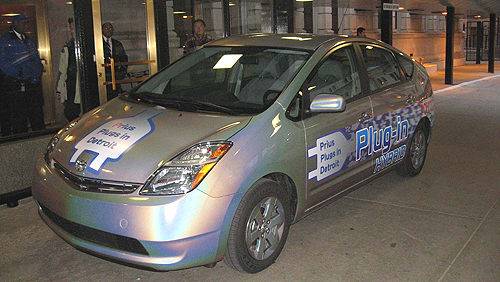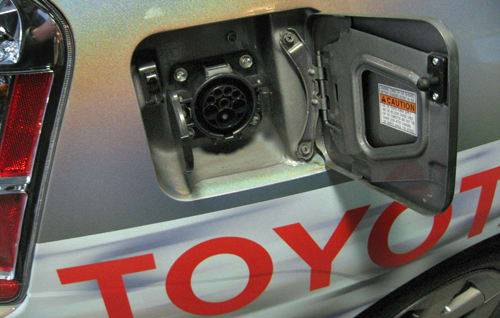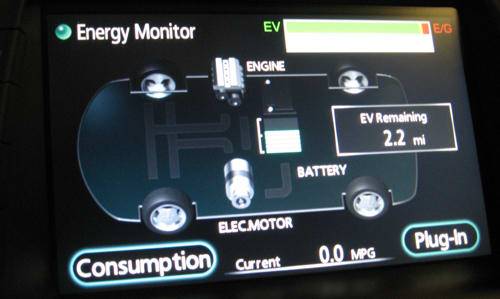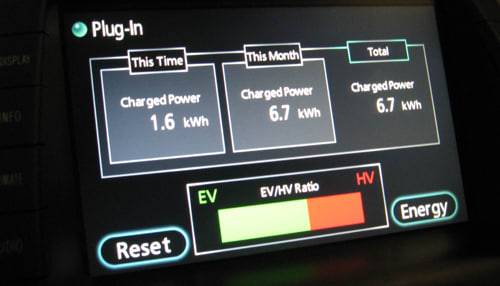First Drive: Toyota Prius Plug-In Hybrid


I assumed that a plug-in version of the Prius wouldn’t be powerful enough when operating in electric-only mode, given that you have to accelerate gingerly in a regular Prius to achieve its top electric-only speed of 30 mph without triggering the gas engine. A drive in an experimental Prius plug-in hybrid, however, proved me wrong.
Here at the Detroit auto show — where sudden hybrid rival GM introduced an upcoming plug-in model and vowed to beat the Japanese pioneer to market — Toyota seized the opportunity to offer Cars.com a test drive. The modified Prius I drove is one of only a handful in the U.S., four of which Toyota has provided to the University of California, Berkeley and Irvine, in conjunction with the Clean Mobility Partnership.

The plug-in Prius is little more than a regular Prius with an additional nickel-metal-hydride battery pack in the space usually occupied by the spare tire. Aside from that, there are some software changes and an outlet on the rear quarterpanel opposite the one with the fuel filler; the Hybrid Synergy Drive system uses the same electric motors, engine and everything else.
An EV button on the dashboard activates electric-only mode, which gives plenty of power for normal acceleration and lets you climb up to 62 mph before the gas engine turns on. This is a wholly different experience than the EV mode in the Highlander SUV and Lexus LS 600hL sedan, which only help a little when it comes to keeping the engine off; accelerate too quickly or up to about 30 mph, and their engines fire up.

The plug-in Prius accelerated at a reasonable rate in EV mode, turning on the gas engine only when I called for heavy acceleration or exceeded 62 mph. Even better, the familiar in-dash touch-screen display gives additional information: The Energy Monitor screen adds a bar graph in the corner that indicates exactly how close you are to triggering the gas engine. By modulating the pedal position, I maintained the electric-only mode as long as I could. More information, Toyota says, helps drivers maximize their mileage.
This screen also shows how much farther you can travel in EV mode until the battery’s depleted — in actual miles. This is a mystery in other hybrids, as battery level appears only as a bar graph. This experimental plug-in has an electric range of about seven miles, but Toyota says that would at least double in a real product, which won’t come until the next-generation Prius — with a lithium-ion battery — does.

So when do we plug it in? The idea is to recharge plug-in hybrids overnight, but this model takes only three to four hours from a 110-volt household outlet. If you use 220 volts, it’s only an hour to an hour and a half. The point behind charging is that it lets you start out with a full battery. Current hybrids often fire up the engine when you turn the car on to top off the battery pack. Even with the seven-mile range on fossil-fuel-free energy, Toyota stresses that the fuel burned by the end of the trip — not how long you go electric only — is what counts.
The additional batteries help out in part by increasing the storage capacity for electricity generated through regenerative braking, which all hybrids do. For example, if you use a lot of juice climbing a hill you can gain more of it back when you coast or brake your way back down. In current hybrids, once the battery is full, any additional braking represents wasted energy.
You might want a mileage figure for this car, but Toyota correctly points out that there’s no reliable way to judge it yet — and that goes for other companies’ plug-ins, too. One of the Clean Mobility Partnership’s goals is to develop such a test cycle, and study the real-world “life-cycle” emissions of electric cars in different regions, because most of the country’s electricity is generated by dirty, carbon-heavy coal. Berkeley’s Institute of Transportation Studies will look into the demand for such cars by cycling drivers through plug-in hybrids, full electrics and other alternative-fuel cars. The viability of alternative propulsion depends on too many factors to mention, but includes the cost of manufacture, how much consumers will pay for what level of performance, and their tolerance for plugging in a car or having shorter ranges between charges or fill-ups.
Overall I’m impressed with the experimental plug-in, partly because the Prius itself is a system designed to operate plug-free. A car designed from the start as a plug-in — as the current car’s successor may be — will invariably be more efficient. Toyota and other automakers are busier than we know, and they keep the details to themselves. As soon as we know any more, you will too.

Former Executive Editor Joe Wiesenfelder, a Cars.com launch veteran, led the car evaluation effort. He owns a 1984 Mercedes 300D and a 2002 Mazda Miata SE.
Featured stories



